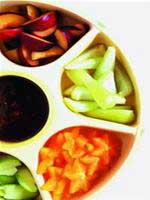How many everyday substances?
 Every day, you may need some energy including certain nutrients such as sugar, protein, fat and vitamins. They come from daily food and drink, but do you know how to best combine them? And what is the health benefit for each substance?
Every day, you may need some energy including certain nutrients such as sugar, protein, fat and vitamins. They come from daily food and drink, but do you know how to best combine them? And what is the health benefit for each substance?
Calories - from 1,600 to 2,800 units a day
Your body will burn sugar, protein and fat into energy. This energy is specifically calculated into calories and a fuel source for you to carry out activities.
The amount of calories you need for each day depends on many factors such as gender, age, weight and daily activities. For example, a retired woman, who does not have to do much and sits in one place only needs 1,600 calories / day but a 25-year-old girl with a busy job will need to work around 1.800 - 2.200 New calories to ensure the body is functioning properly and without deficiency. Here is the calorie table needed for each age.
-
1,600 calories - children 2 to 6 years old and retired elderly
-
2,000 calories - adults have jobs that are not too heavy
-
2,200 calories - teenagers who are developing their bodies and those who have a lot of physical activity
-
2,800 calories - athletes and people with special requirements for nutritional supplements.
Protein makes up 10-35% of total calories
It's not too much to say that protein is the basic ingredient in life because every cell in your body contains it. Skin, bones, muscles and internal organs all have the main constituents of protein. It can also be found in blood, hormones and enzymes.
Protein can be found easily in many different foods. Plants of legumes, poultry, seafood, pork, beef, dairy products, starch . are all rich in protein. However, you should also be careful with protein-rich foods, do not eat them too much because a protein-rich dish is also high in fat and cholesterol.
The amount of protein that is suitable for your body depends on your weight. For example: A woman weighing about 50-55kg will need 51 g of protein a day, a woman weighing about 55 to 60 kg will need 64gr. Or in other words, you can calculate an average rate: For every kilogram of weight you will need 0.8kg of protein so your body does not starve.
Sugar (carbohydrate) - accounts for 45 to 65% of total calories
Sugar is the primary source of energy for you, the fuel for smooth functioning of your organs without any problems. The main sugar is starch and sugar. Starch is found in flour, rice, pasta, cereals and some kinds of fruits such as potatoes, sweet potatoes . Sugar is found in fruits, processed foods taste like butter. milk, cream, sweet cake .
Taking up 45-65% of your daily calorie intake means you have to absorb about 130g in 3 meals. The reason because the time your body absorbs sugar is longer than refined sugar, so you will lose more energy for this and the ability to gain weight is also less. In addition, fresh fruits and milk are naturally more nutritious than candies. Processed foods often contain quite a lot of calories but have few vitamins and minerals.
Fat - accounting for 20-35% of total calories
Unlike protein and sugar, fat is also a form of energy like adding water. Fat contains a number of important vitamins, which make the internal organs more stable and also make the immune system work more efficiently. But too much fat is not good at all, they will make you gain weight, fat and accompanying dangerous diseases like heart disease, blood fat .
Cholesterol - not more than 300 milligrams per day
Everyone knows that high cholesterol rates are dangerous to health but the body may also lack them. Simply because everyday foods like all meat, dairy products, carbonated water . always contain a high amount of cholesterol. What you need to do now is that you have to limit these foods, instead of containing very little or no cholesterol such as vegetable oil, green vegetables, fruits .
In addition, soluble tissues can help you reduce cholesterol and control blood sugar. You can find it in oats, dried beans and some fruits like apples, oranges, strawberries and grapes.
- 3 everyday items you won't believe are from ancient Egypt
- Top 10 most dangerous substances on the planet
- Kill insects with 'tips'
- The 5 most addictive substances on Earth
- 7 items everyone knows are toxic but still used daily
- Radioactive substances in cigarettes are hidden
- 30 familiar widgets are integrated in your smartphone
- Tragedy of those who suffer from the 5 most strange allergies on the planet
- Radiation reduction with corn cobs
- Why not fire itself off?
- Using unleaded gasoline but the lead in the air increases!
- There are more than 4,000 different substances in the blood
 Green tea cleans teeth better than mouthwash?
Green tea cleans teeth better than mouthwash? Death kiss: This is why you should not let anyone kiss your baby's lips
Death kiss: This is why you should not let anyone kiss your baby's lips What is salmonellosis?
What is salmonellosis? Caution should be exercised when using aloe vera through eating and drinking
Caution should be exercised when using aloe vera through eating and drinking